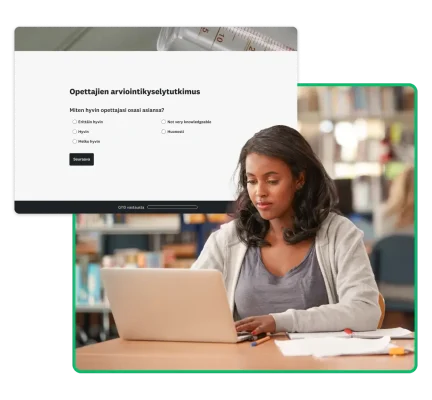Toteuta tehokkaita opettajien arviointikyselytutkimuksia
Näin luot oppilaita kiinnostavia kyselytutkimuksia ja sujuvoitat prosessia valmiilla opettaja-arviointien kyselytutkimusmalleilla.

Kun saat rehellistä ja laadukasta palautetta oppilailta, voit tehostaa opetusta ja osoittaa kasvuhalukkuutta. Oppilaiden mielipiteiden mittaamisen lisäksi opettajia arvioivat kyselytutkimukset auttavat opettajia hiomaan opetustaitojaan ja varmistamaan, että opetus on yhtenäistä.
Seuraavaksi saat tietää, millaisia opettajia arvioivat kyselytutkimukset ovat, miksi ne on tärkeää tehdä oikein ja miten opettaja-arvioinnit voivat auttaa sinua sekä parantamaan opetustuloksia että etenemään urallasi.
Opettajien arviointi
Opettajien arviointi tarkoittaa opettajien suoriutumisen ja tehokkuuden mittaamista.
Arvioinnit voidaan tehdä esimerkiksi tarkkailemalla opettajien työtä opetustilanteessa, minkä lisäksi voidaan käyttää opettajia arvioivia kyselytutkimuksia.
Esimerkiksi lukion rehtori voi pyytää oppilailta säännöllistä palautetta kyselytutkimuksilla.
Opettaja-arviointien edut
Opetuksen laatua ei voi parantaa selvittämättä, mitä osa-alueita on parannettava. Tämän vuoksi erityisesti oppilaille suunnatuilla opettaja-arvioinneilla kerätään parannustoimissa tarvittavia havaintoja.
Osoita opetuksen tehokkuus
Opettaja-arvioinneilla selvitetään opetuksen tehokkuutta, jotta strategioista voidaan tehdä tuloksekkaita.
Stanfordissa tehdyssä tutkimuksessa havaittiin, että opettajien tehokkuus sekä parani arviointivuoden aikana että pysyi samalla tasolla useita vuosia arvioinnin jälkeen.
Arvioinneista voi olla muitakin etuja kuin oppilaiden menestys. Keräämäsi data voi osoittaa opettajien kehittymistä ja edistää heidän uraansa, sillä esimerkiksi myönteiset oppilastulokset ja opettaja-arvioinnit voivat auttaa opettajia saamaan ylennyksiä ja vakinaisia virkoja.
Luo parempia opiskelijakokemuksia
Kun selvität työkalujen, tuen ja rahoituksen puutteet, voit parantaa oppilaiden oppimiskykyä ja sitoutumista tunneilla. Koetuloksia pidetään osoituksena oppilaiden osaamisesta, mutta opettajien tehokkuus ei aina käy niistä ilmi, minkä vuoksi opettaja-arvioinnit voivat antaa tarvittavia lisätietoja.
Kuvittele esimerkiksi tilanne, jossa oppilaat saivat hyviä kurssiarvosanoja, mutta sanoivat myöhemmin, etteivät ymmärtäneet kurssimateriaaleja kovin hyvin. Opettaja sai selville, että vaikka oppilaat olivat valmistautuneet kokeeseen, heillä oli vain pinnallinen käsitys aineistosta.
Tällöin opettajan on ehkä panostettava enemmän siihen, että oppilaat todella ymmärtävät käsitteet eivätkä vain opettele niitä ulkoa.
Kartoita jatkokoulutustarpeet
Opettaja-arvioinnit selventävät ammatillisen kasvun tarpeita, mikä auttaa hakeutumaan sopivaan lisäkoulutukseen tai etsimään materiaaleja opetuksen tueksi. Esimerkiksi koulun johtaja voi saada selville oppilaiden kyselytutkimuksista, että liikuntarajoitteiset oppilaat eivät pääse käyttämään luokkahuoneessa saatavilla olevia materiaaleja. Opettajat saattavat kaivata lisäoppia vaihtoehtoisten materiaalien tuottamiseen.
Huomaa: Opettajien jatkokoulutus on korvaamattoman arvokasta urakehityksen kannalta, ja monet opettajat pitävätkin yllä taitojaan osallistumalla säännöllisesti erilaisiin koulutustilaisuuksiin.

Oppilaille suunnatut opettaja-arviointien kysymykset
Jos tarvitset ideoita opettaja-arviointeihin, voit käyttää näitä opettajia arvioivia kyselytutkimuskysymyksiä.
- Miten hyvin opettajasi osasi asiansa?
- Erittäin asiantuntevasti
- Asiantuntevasti
- Melko asiantuntevasti
- Ei kovin asiantuntevasti
- Ei lainkaan asiantuntevasti
- Kuinka selkeästi opettaja esitteli kurssiaineiston?
- Erittäin selkeästi
- Selkeästi
- Melko selkeästi
- Ei kovin selkeästi
- Ei lainkaan selkeästi
- Miten hyvin opettaja mielestäsi tunsi oppimateriaalinsa?
- Erinomaisesti
- Hyvin
- Aika hyvin
- Ei kovin hyvin
- Huonosti
- Kuinka hyvin opettaja vastasi opiskelijoiden kysymyksiin?
- Erittäin hyvin
- Hyvin
- Melko hyvin
- Ei kovin hyvin
- Ei lainkaan hyvin
- Oliko kurssi liian helppo, liian vaativa vai suunnilleen sopiva?
- Aivan liian helppo
- Liian helppo
- Suunnilleen sopiva
- Liian vaativa
- Aivan liian vaativa
- Kuinka hyödyllistä oli tehdä kotitehtäviä aineiston ymmärtämisen kannalta?
- Erittäin hyödyllistä
- Hyödyllistä
- Jossain määrin hyödyllisiä
- Ei kovin hyödyllistä
- Ei lainkaan hyödyllistä
- Miten totuudenmukainen seuraava väittämä on? Uskon oppineeni paljon tästä aiheesta kurssin aikana.
- Hyvin totuudenmukainen
- Totuudenmukainen
- Melko totuudenmukainen
- Ei kovin totuudenmukainen
- Ei lainkaan totuudenmukainen
- Miten helppoa opettajalle oli esittää kysymys tai huolenaihe?
- Erittäin helppoa
- Helppoa
- Melko helppoa
- Ei kovin helppoa
- Ei lainkaan helppoa
- Kuinka selkeästi opettaja kertoi kurssin tulevasta annista?
- Erittäin selkeästi
- Selkeästi
- Melko selkeästi
- Ei kovin selkeästi
- Ei lainkaan selkeästi
- Kuinka hyvin opettaja pitäytyi opetussuunnitelmassa?
- Erittäin hyvin
- Hyvin
- Melko hyvin
- Ei kovin hyvin
- Ei lainkaan hyvin
- Esittelikö opettaja kurssiaineiston liian nopeasti, liian hitaasti vain sopivaan tahtiin?
- Aivan liian nopeasti
- Liian nopeasti
- Sopivaan tahtiin
- Liian hitaasti
- Aivan liian hitaasti
- Mistä pidit eniten/vähiten tällä kurssilla?
- Millä tavoin tämä opettaja sai oppilaat kiinnostumaan kurssista?
- Onko sinulla opettajalle muita terveisiä?
Huomaa: kysymykset 12–14 ovat avoimia, joten oppilaiden on kirjoitettava vastauksensa omin sanoin.
Kysymykset opettajan tehokkuudesta
Näitä ovat esimerkiksi seuraavanlaiset kysymykset: ”Kuinka selkeästi opettaja esitteli kurssiaineiston?” ja ”Kuinka kattavasti opettaja vastasi opiskelijoiden kysymyksiin?”. Näihin kysymyksiin annetut vastaukset auttavat määrittämään, kuinka tehokkaasti oppilaat saivat neuvoja opettajalta ja kurssin tehtävistä.
Jos arviointia ei tehdä nimettömänä, haluat ehkä verrata oppilaiden arvosanoja ja läsnäoloa kyselytutkimusvastauksiin. Jos usein poissa olevat oppilaat pitävät opettajaa huonona, tilannetta voidaan korjata esimerkiksi kannustamalla oppilaita saapumaan tunneille tai tarjoamalla heille etäopiskelumateriaaleja.
Oppilaiden kasvua ja kehittymistä koskevat kysymykset
Esimerkiksi seuraavat oppimisen määrää ja laatua arvioivat kysymykset voivat antaa tietoa oppilaiden kehittymisestä:
- Oliko kurssi liian helppo, liian vaativa vai suunnilleen sopiva?
- Kuinka hyödyllistä oli tehdä kotitehtäviä aineiston ymmärtämisen kannalta?
- Miten totuudenmukainen seuraava väittämä on? ”Uskon oppineeni paljon tästä aiheesta kurssin aikana.”
Voit esittää kysymyksiä myös mukautuksista, sillä esimerkiksi oppimisen vaikeuksista kärsivät oppilaat voivat tarvita apua pysyäkseen kurssilla muiden perässä.
Kysymykset opetustilanteen hallinnasta
Jos haluat tietää, kuinka hyvin opettaja hallitsee opetustilanteen, voit kysyä esimerkiksi: ”Millä tavoin kyseinen opettaja sai oppilaat kiinnostumaan kurssista? [avoin kysymys]” ja ”Esittelikö opettaja kurssiaineiston liian nopeasti, liian hitaasti vain sopivaan tahtiin?”.
Kun opettaja osaa hallita hyvin opetustilannetta, oppilaat kehittyvät ja oppivat, mikä voi saada myös opettajat viihtymään työssään paremmin.
RAND-järjestön tekemän tutkimuksen mukaan stressi on yleisin syy sille, että opettajat jättävät työnsä julkisissa kouluissa Yhdysvalloissa. Kun opetustilanne on hyvin hallinnassa, luokkahuone on oppimiselle otollinen ja rauhallinen, mikä vähentää sekä oppilaiden että opettajien stressiä.
Näihin kysymyksiin annetut vastaukset auttavat opettajia arvioimaan omia opetustilanteen hallintataitojaan ja omaa suhtautumistaan luokkahuoneessa.
Opettaja-arviointien haasteet ja rajoitukset
Opettaja-arvioinnit eivät ole kaikenkattavia, vaan niissä on joitakin erityisratkaisuja vaativia puutteita. Pidä mielessä seuraavat yleiset haasteet ja vinkit niiden ratkaisemiseen.
1. Kaikki oppilaat eivät ole sitoutuneita
Jotkut oppilaat eivät osallistu opettaja-arviointeihin esimerkiksi seuraavista syistä:
- Heidän kiinnostuksensa lopahtaa tunnin tai lukuvuoden lopussa.
- He asettavat muut oppiaineet etusijalle erityisesti, jos arvioinnit tehdään vuoden lopussa samaan aikaan loppukokeiden kanssa.
- He eivät pidä kyselytutkimuksista ja kieltäytyvät niihin vastaamisesta.
Vaatimus kyselytutkimuksiin vastaamisesta voi myös aiheuttaa ongelmia, sillä oppilaat saattavat tällöin vastata huolimattomasti tai tarpeettoman kriittisesti vain täyttääkseen vaatimuksen. Suosittelemme valmistautumaan vajaisiin vastauksiin ja kehottamaan oppilaita vastaamaan vain niin halutessaan.
2. Nimettömät ja nimelliset kyselytutkimukset
Kyselytutkimuksissa joko kysytään vastaajan nimeä tai sitä ei kysytä. Kummassakin lähestymistavassa on omat haittansa ja hyötynsä. Nimellisissä kyselytutkimuksissa oppilaat eivät ehkä vastaa täysin rehellisesti, koska he pelkäävät kielteisiä seuraamuksia tai eivät halua vastata mahdollisiin jatkokysymyksiin.
Saatat saada enemmän vilpittömiä vastauksia täysin nimettömiin kyselytutkimuksiin, minkä vuoksi kyselytutkimukset kannattaa tehdä nimettöminä eli anonyymeina.
Muista kuitenkin, että vaikka voit saada täsmällisiä vastauksia nimettömistä kyselytutkimuksista, ne eivät auta karsimaan poikkeamia. Et esimerkiksi voi poistaa vastauksia oppilailta, joille on määrätty kurinpitotoimia tai joilla on paljon poissaoloja.
3. Pitkäkestoiset kyselytutkimukset
Kattavilla kyselytutkimuksilla kerätään yksityiskohtaista ja käyttökelpoista palautetta, mutta ne voivat saada oppilaat väsymään. Pitkän kysymyslistan nähdessään oppilaat voivat kiirehtiä vastauksissaan, antaa vääriä vastauksia tai vaikka jättää vastaamisen kesken, mikä voi vaikuttaa merkittävästi datan laatuun ja käyttökelpoisuuteen.
Voit selättää tämän haasteen muokkaamalla arvioinnit oppilaiden iän, taitojen ja koulutustavoitteiden mukaisesti. Koska esimerkiksi lukiolaisella voi olla heikompi keskittymiskyky kuin aikuisoppilaalla, vastaajien ominaisuudet kannattaa huomioida kyselytutkimuksen pituudessa.
Lyhyet ja ytimekkäät kyselytutkimukset, joissa keskitytään tiettyihin opetuskäytäntöihin, voivat kannustaa vastaamaan harkitusti iästä riippumatta. Tiedustele siis opetusmenetelmien tärkeimmistä osa-alueista selkeillä ja yksinkertaisilla kysymyksillä.
4. Epäsäännölliset arviointijaksot
Jos oppilaitokset eivät toteuta opettaja-arviointeja johdonmukaisesti ja säännöllisesti, opettajien edistymisen ja kehittymisen mittaaminen vaikeutuu.
Arviointeja kannattaa toteuttaa jokaisen oppitunnin päätteeksi, ja niiden on oltava yhdenmukaisia lukukaudesta toiseen. Jos opettaja-arviointien kysymyksiä muutetaan liikaa, suoriutumisen vertaaminen sekä kehitettävien osa-alueiden löytäminen on haastavaa.
5. Luontaiset ennakkoasenteet ja puolueellisuus
Yhdysvaltalaisen Inside Higher Ed ‑verkkojulkaisun mukaan esimerkiksi ”naispuolisia opettajia koskevissa oppilaiden tekemissä arvioinneissa voi esiintyä sukupuoleen liittyviä ennakkoasenteita”. Arviointeihin voi liittyä myös muunlaista puolueellisuutta. Esimerkiksi:
- henkilökohtaista puolueellisuutta esiintyy, kun oppilas omista syistään pitää tai ei pidä opettajasta
- etnistä alkuperää koskevaa puolueellisuutta esiintyy, kun opettajan tehokkuus määritetään esimerkiksi ihonvärin perusteella
- oppiainetta koskevaa puolueellisuutta esiintyy, kun opettajan suoriutuminen määritetään aihepiirin perusteella.
Yhdysvaltalaisen Assessment & Evaluation in Higher Educationin julkaisemassa tutkimuksessa puolueellisuutta vähentäviksi toimiksi suositellaan itsenäisten arvioijien käyttämistä, oppilashaastatteluja, asiantuntijoiden tekemiä havaintoja opettajista opetustilanteessa sekä oppimateriaalien ja kyselytutkimusten tulosten vertaisarviointeja.
Näin teet opettaja-arvioinnin kyselytutkimuksen
Paras ja helpoin tapa selvittää oppilaiden mielipiteet opetuksesta ja kurssista on pyytää heitä täyttämään opettaja-arvioinnin kyselytutkimus.
Kun lähetät oppilaille arviointikyselytutkimuksen, annat heille mahdollisuuden vaikuttaa asioihin, mikä voi auttaa myös sinua havaitsemaan muutosta kaipaavat osa-alueet.
Kun olet valmis aloittamaan, seuraavat vaiheet auttavat keräämään oppilaspalautetta opettajia arvioivilla kyselytutkimuksilla.
Esittele kyselytutkimuksen tarkoitus ja tavoitteet
Selitä, miksi lähetät kyselytutkimuksen oppilaille, miten aiot hyödyntää dataa ja miksi arvostat rehellistä palautetta.
Kerro yksityiskohtaisesti henkilökohtaisista opetustavoitteistasi arvioinnin suhteen, joihin voi lukeutua esimerkiksi tahtosi kehittyä ja auttaa oppilaitakin kehittymään. Ilmoita myös, saavatko oppilaat vastata nimettömästi ja näkevätkö muut tahot oppilaiden vastaukset.
Vanderbiltin yliopiston Center for Teaching ehdottaa myös oppilaspalautteen mainitsemista opetussuunnitelmassa. Tämä korostaisi palautteen kuuluvan olennaisena osana opetukseen ja voisi saada oppilaat kiinnittämään huomiota kokemukseensa kurssillasi, minkä ansiosta he olisivat aikanaan valmiita vastaamaan palautekyselytutkimuksen kysymyksiin.
Kysy oikeat kysymykset
Jos haluat tietää, millaisilla kysymyksillä saat arvokasta oppilaspalautetta, mieti, millaisia tuloksia haluat opettajaa arvioivasta kyselytutkimuksesta.
- Haluatko selkeän käsityksen siitä, miten oppilaat suhtautuvat opetustyyliisi tai miten helpoksi he kokevat kysymysten esittämisen?
- Haluatko tarkkaa tietoa ensisijaisesti kurssin työmäärästä, tahdista tai rakenteesta sekä mahdollisesti myös opetustavastasi? (Kurssia arvioivan kyselytutkimuksen mallimme voi olla avuksi tässä.)
Mieti, millä tiedoilla voit parantaa sekä opetustapaasi että suhdettasi oppilaisiin. Saat parhaat tulokset käyttämällä erilaisia kysymystyyppejä sekä varmistamalla, että lisäät avoimiin kysymyksiin tekstiruudun omin sanoin annettaville vastauksille.
Esimerkiksi yliopisto-opettajan arvioinnin kyselytutkimusmallissa on erilaisten monivalintakysymysten lisäksi mahdollisuus antaa palautetta opettajan erityisistä ansioista ja parannettavista osa-alueista.
Pyytäessäsi oppilaita vastaamaan omin sanoin annat heidän tuoda esiin asioita, jotka ovat saattaneet jäädä sinulta huomaamatta. Varmista kuitenkin, että suurin osa kysymyksistä on suljettuja, sillä vastausten kirjoittaminen vie aikaa, ja haluat varmasti mahdollisimman monen oppilaan vastaavan kyselytutkimukseesi.
Etsi suuntauksia ja tee muutoksia datan perusteella
Oppilaspalautteen arviointi voi olla haastavaa, joten siihen on hyvä suhtautua avoimin mielin pitäen silmällä parannusta vaativia suuntauksia.
Jos esimerkiksi käy ilmi, että 80 % oppilaistasi pitää tiettyä tehtävää vaikeana, voit harkita muutoksia ohjeisiin, vaatimuksiin tai tehtävään liittyvään oppituntiin.
Aseta vertailuarvo tulevaa varten
Ota opettaja-arvioinnit tavaksi lähettämällä niitä säännöllisesti kurssien päätteeksi tai vaikkapa keskellä lukukautta. Näin voit tarttua ongelmiin ennen kurssin loppumista sekä verrata kyselytutkimusten tuloksia. Vertailu on tärkeää, sillä se auttaa seuraamaan kehittymistä ja asettamaan tavoitteita tulevia arviointeja varten.

Lisää opettaja-arviointien esimerkkejä ja materiaaleja
Kyselytutkimuksilla voi kätevästi täydentää jo ennestään kattavia opettaja-arviointeja sekä opettajien tekemiä oppilasarviointeja. Esimerkiksi Yhdysvalloissa opettajat kertovat oppilaiden valmiuksista yliopisto-opiskeluun Common App ‑arvioinneilla.
Jos tarvitset apua päästäksesi alkuun, tutustu kouluopetukseen liittyviin kyselytutkimuksiin sekä näihin hyödyllisiin opetushenkilökunnalle tarkoitettuihin malleihin:
Pääset alkuun tutustumalla kaikkiin muokattaviin kouluopetukseen liittyviin kyselytutkimusmalleihin tai katsomalla, kuinka SurveyMonkey voi auttaa luomaan opettajien arviointikriteerit, keräämään oppilaiden palautetta sekä parantamaan kokemusta opetustilanteessa.
Tutustu muihin materiaaleihin

Opetusmenetelmien parantaminen luokalta saadun palautteen avulla
SurveyMonkeyn koulutusratkaisujen avulla voit kysyä opiskelijoilta ja opetushenkilökunnalta juuri oikeat oppimiskokemuksia parantavat kysymykset.

Hanki verkkoarviointilomakkeilla palautetta, jonka perusteella voit toimia
Hyödynnä palautetta SurveyMonkeyn verkkoarviointilomakkeiden avulla. Aloita heti lomaketyökalullamme.

Päivähoidon ilmoittautumislomakkeen malli
Tehosta päivähoitoon ilmoittautumista päivähoidon ilmoittautumislomakkeen mallilla. Muokkaa se tarpeitasi vastaavaksi SurveyMonkeyn lomaketyökalulla.

Alumnien ilmoittautumislomakkeen malli
Pysy yhteydessä oppilaitoksesi alumneihin ilmoittautumislomakkeen mallimme avulla. Muokkaa sitä tarvittaessa intuitiivisella lomaketyökalullamme.